Elizabeth Moon's Blog, page 28
May 23, 2012
Reality Versus the Fiction Writer
1) Do I really think everyone should be barcoded?
Of course not.
Seriously...you thought it was for real? After hearing about responses to the photographer who thought everyone should be limited to just one photo a day, you still thought this was a dead-serious part of the discussion? The term "Empress of the Universe" wasn't a clue that this was a science fiction writer making something up?
2) So why....?
The format of "The Forum" has this sixty second idea thing in it. I was told it was the entertaining, fun part of the show. I interpreted that as "light-hearted interlude." Participants are asked to come up with an idea--however impractical, impossible, unnecessary, and/or undesirable. The BBC staff picks one and the person whose idea it was is then supposed to present and defend it.
I don't know about the others, but I tossed out several ideas over the phone, and they didn't seem to create any interest. The idea is supposed to be related to the day's topic (there went my idea for putting solar panels on top of cars in all sunny climes...) It's not supposed to be related to things the participant has already given as points they might want to make in the main discussion (there went another idea or two, including an implant to manage aberrant brain chemistry in soldiers so they wouldn't commit stress-related errors, have rage episodes, maybe even prevent PTSD) or points put forward by the other participants when their main statements are known (and there went something else I didn't even mention to them.) When the first few got "Yes, but..." reactions, I thought "Oh, good, someone else's idea will be used." I'd been told the right one would be picked on the weekend. The weekend went by. Whew. Off the hook.
Then came Monday. "We're really looking forward to your 60-second idea." What??!! I guess it's understandable...if you've got a science fiction writer on tap, let her come up with ideas. Maybe they'll be...off the wall. Exciting. Innovative.Meanwhile, this fiction writer had been trying to grasp the economics of caravel-size tradeships in a fictional trade route on a fictional world and factor in the effect of (totally imaginary) magic. Who ships what to whom, and what are the relative values? Orbis (the wonderful Roman-era trade route map from Stanford University, check 'em out) had just come online publicly in the last few weeks and I'd spent hours searching it for things useful to the book project. One scratch pad had fictional-currency/drachma conversion calculations; another was covered with notes and questions and reminders of things seen in museums and spotted on PBS archaeology programs, and yet another held the timeline calculations, comments on currents and weather, etc.
So the request for another (and better, in BBC terms) idea for a future wars, science-fictional, discussion-sparking, doesn't-appear-elsewhere-in-the-briefs, topic... fell into my day like a cannonball.
Even so, I came up with two ideas.
Out of recent science journal reading came a mixture of several articles on bar-coding species, one from somewhere else on the use of implanted chips to give medical information to hospitals when patients with chronic serious illness, who had to travel, might have an emergency far from home, another on the use of combination locator/identity chips for nonverbal and illiterate people (elderly with Alzheimer's, people with autism, mutism, etc.) who tended to wander and were picked up by police who didn't--without more information--understand these people and treated them as drug-overdoses or criminals. Having read the others' briefs, the connection of "secure identity" to "accountability" dragged this toward the day's topic.
The other idea was time-limited munitions that wouldn't hang around for years being a hazard for anyone who walks across the ground...though as it was near midnight by then, and I'm a morning person, the complete concept of this didn't hit me until early morning. (Nitrogen-based explosives could be set--one way or another--to degrade to fertilizer. Could be controlled either by departing forces initiating the degradation or environmentally modulated. Maybe "land-mine-casing-eating bacteria"??)
So I sent these off just before midnight, reasonably sure they'd pick the degradable munitions, even though I hadn't yet worked the idea out in detail, but it was certainly closer to the day's topic. And I could flesh it out the next morning. I thought. Morning arrived too early, waking me up with the fertilizer, engineered bacteria to eat the container and reduce it to more good soil stuff ideas. I would prod them to use that one, I thought blithely at something like 5 am. Then I fell asleep again. By the time I got up and turned the computer on (and I have no idea when that was) they'd chosen the bar-code identity chip one and it was Tuesday afternoon in London. And wanted me to write and rehearse a version that would read in exactly 60 seconds. There were emails back and forth. Much writing/re-writing. Much practice.
3) But still....why?
Because I'm a science fiction/fantasy writer. Impractical, impossible, unpalatable, downright weird and peculiar ideas are what we play with all the time. Tell us to go wild, or to be creative, and we take off all the brakes and filters. Having been in the field for over twenty years now, and having been in hundreds of free-wheeling idea-storms with other writers and with those who read our stuff...that's my response when asked for nifty ideas. It's a game. The ideas are not intended to be realistic or serious (though some of them turn out later to be more practical than first thought) ...they're tossed up as jugglers toss their balls and knives and whatever. Toss them, watch them tumble in the air, discard if they don't fit the story in progress. It's fiction--not reality.
Moreover, we're used to arguing both sides of a question. Present an idea and defend it? Sure. Present an idea and tear it apart? Sure.
Now given time to include an idea in a book (more than a few hours to think one up, and months to write the book) we'll clothe an idea that passes the idea-juggling competition in whatever our native philosophy is. There are science fiction/fantasy writers at every point on the political scale...people I consider falling off the cliff on the right and others I consider falling off the cliff on the left and the rest of us strung out along the spacious middle on every axis of politics, economics, philosophy, religion. Most ideas (of the jugglers' ball sort) can be used by anyone, but for different effect.
But when not given time...asked to throw out ideas...I throw out ideas.
4) But you said "Empress of the Universe..."
Yes, and since I'm not an actress, just a writer, I was not able to infuse into that phrase the vocal cues that would have told all of you it was a clue--intentionally a clue--that the rest of the proposal was not serious. I thought the words were outrageous enough that everyone would get it. Clearly, I was wrong.
To be very, very clear. I know I'm not the Empress of the Universe or anything else. I do not want to be Empress of the Universe. If beams shone down from giant alien spaceships and a voice from the heavens said "Here is your crown, O Empress of the Universe" I would fall over laughing (somebody's playing a joke) and refuse in terms they could not mistake.
Empress of the Universe would be way too much work. I'd have to wear fancy clothes, probably including lady shoes with pointed toes, and could no longer slouch into the study in PJs and slippers. Someone would (avert!) straighten my desk. Someone would reorganize my yarn stash...in fact, they'd assign someone else to knit my socks, thus depriving me of an excuse to rest my brain while pretending to accomplish something useful. There would be some kind of household to manage (instead of a house to mismanage) and people would expect to be told what to do. Maybe they'd even try to keep me on a schedule. Yuck! I have better things to do with my time.
May 17, 2012
And on the Home Front: Green Socks Have Heels
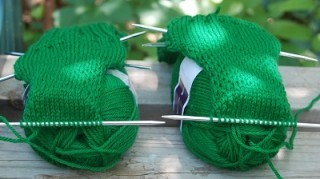 .
.The "eye of partridge" stitch shows clearly on the heel flap. I did the heel turn itself in stockinette. The center portion of the heel (the part with stitches that run "straight" from the back of the leg around and under) has eight stitches. That's the same as on the blue pair that preceded this pair. The heel flap itself is 28 stitches, two stitches narrower than the blue pair's heel flap because I decreased four stitches below the cuff ribbing. Now to pick up the stitches along the side of the heel flap and reconnect the heel to the top of the sock.
With the family out of the house, I should be able to do this without interruption. I'd like a nap, actually (short of sleep again last night) but it's too good a chance to miss. It felt really good to have today's knitting do so well, after yesterday's fiasco.
Is That Me on a BBC Radio program? Yes!
"The Forum" has a superb moderator, who managed to keep us all more or less on track and moving forward, without being a tyrant about it--there was natural flow to the conversation. I enjoyed it immensely. There's information on broadcast times in the UK, plus links to the podcast or--if you want to check it out later--the archives of the series--below the cut. This is what the BBC sent me.
UK tx times, on DAB, cable, Freeview are: Sat 19th May 23:05, Sun 20th May 02:05, 12:05
Go to: http://www.bbc.co.uk/worldservice/programmeguide/ for times outside the UK - there are a number of US stations that take parts of BBC WS output so there may be one near you. It is also available on satellite radio. (BTW if clicking on any of the links on this page doesn't work - or if you get asked for passwords - please copy and paste them into your browser)
It will also be available online (as a stream or download/podcast) from Sunday, at
http://www.bbc.co.uk/programmes/p00rrvw8
and it will be permanently available in The Forum archive:
http://www.bbc.co.uk/programmes/p004kln9/episodes/player
You can also access the programme or point others to it via Itunes and similar podcatchers.-------------------------------------------
And now it's back to work on the current book, and on knitting, after a notable Knitting Fail yesterday when I had to rip one project back to plain yarn.
It was one of the red socks that are in line after the green socks. I should've taken a picture of it at its worst, but it developed a fatal illness that all my tinkering wouldn't cure--and the tinkering took hours of ripping, rescuing stitches, rearranging the rescued stitches back onto the right needles in the right order, re-knitting...and when I saw that the flaw was not corrected even then....well, it was time to call it quits. So that yarn is wound around its ball, in hopes that it will relax from its trials, and I'm going to start that sock again with fresh yarn (yes, I had another pair's worth of yarn in the same dye lot.) Its twin never developed the problem, and its ribbed cuff looks like a ribbed cuff. Still don't know what I did wrong, but I sincerely hope I never do it again. Meanwhile, it's time to turn the heels of the green socks and get going on their feet. The red socks should follow them, and a light blue pair--called "denim" by the yarn company--will follow the red, most likely.
I wore the blue pair (second pair ever, also known as BlueOne) to the recording studio yesterday. They've been washed and are drying now. My feet were happy from 5:30 am, when I put them on, to midnight, when I took them off.
May 12, 2012
Eye to Eye of Patridge
However, here's where I am on one of the socks (having speared the heel flap with a knitting needle to keep it from curling so much I couldn't photograph it.)
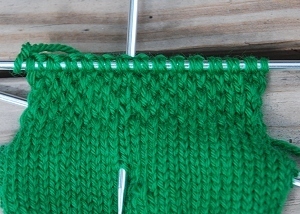
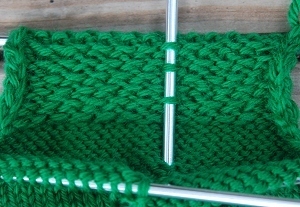
(R) Eye of Partridge stitch above, stockinette below (L) Wrong, or "inside" of heel flap showing EP purl above, regular below
I don't think I'll be using it on heel flaps again--will try "heel stitch" instead--but may use it on small decorative areas, as on afghan or scarf segments. Also don't think it looks much like a partridge's eye, but as there are thousands of stitch patterns, finding unique and appropriate names for each one must be difficult.
Since I didn't do the sensible thing and do a pattern swatch before starting it, I know it's affecting my gauge but not how much. (Yes, sometimes it really is smart to do that swatch ahead of time. Sigh. Well, I have two more balls of green yarn to play with, if these socks turn out to be a very difficult fit...)
Another bit of advice-from-experience: don't try a new stitch pattern when you're in a hurry and have a hard deadline on when something must be done. Too late now for me, but maybe that will help someone else. If I'd just knitted the heel flaps in stockinette, as I did the first two pairs of socks, I'd be a lot closer to turning the heels (which I'd planned to do today...I would've finished the heel flaps yesterday or early today. Minor adjustments done with fitting, like the 4 stitch decrease mentioned above, don't slow you down nearly as much as having to remember which row you're on for patterning. If Interrupted, I can stop stockinette anywhere--I'm either knitting or purling whole rows at a time, and all the knit and purl rows are the same. Here...no.
May 10, 2012
Gay Marriage
But here I am again. Saying the same things again, with emphasis. And congratulating President Obama for coming out in favor of legalizing gay marriage. I am appalled at the continued efforts to make gay marriage illegal, especially since these efforts are based on false premises and equally faulty logic.
When someone says that X imperils Y, they usually have a mechanism in mind, and--for physical things--can usually say what it is. Dropping a glass on concrete imperils the glass: glass is brittle and will break when it hits a hard surface. Some people claim that allowing gay marriage would imperil traditional marriage. But they have no mechanism to display. How--exactly, by what mechanism--is the marriage of two men, or two women, supposed to imperil the marriage of a man and a woman? What does it do?
A bit of boundary discussion here: who's responsible for what, and how that relates to marriages. An individual is responsible for his/her own behavior. Individuals who form a relationship (be it a marriage or a business partnership or a friendship) are both (or all, if more than two) responsible for the success or failure of that relationship. The relationship will prosper, or not, as they invest in it the better parts of their character: honesty, courage, compassion, etc. If three guys go on a fishing trip, the success of that trip will depend on each one doing his part....and if one is a whiner, and one is a boaster and one didn't bring the food he promised to bring, the misery they cause each other has nothing to do with the fact that in the next campsite three women are also on a fishing trip, having a great time, and catching trout hand over fist. Each group created its own experience.
It's the same with marriages. The success or failure of a marriage rests on the people in the marriage. If the marriage tanks, they blew it. Not "society", not the in-laws, not the media, not the marriages of other people in the neighborhood or the social club or the church--not anything but the people themselves...male or female, in any combination that occurs. The quality of a marriage is determined by the behavior of the people in the marriage.
So....how, exactly, could the existence of gay marriages threaten traditional marriages, with the responsibility for the health of a marriage squarely on its partners? Does accepting gay marriage mean that everyone has to have a gay marriage? No. No more than having traditional marriages means that everyone has to have a traditional marriage. Does gay marriage mean that a straight marriage is doomed to fail? No. So...how does it threaten them?
Clearly, it can't. So those who oppose gay marriage have to leave the mechanism alone and take another route, the appeal to authority, what they say God said. But the texts quoted do not say that gay marriages threaten traditional marriages...the closest they get is that God supposedly said marriage was between a man and a woman. So the only legitimate approach to opposing gay marriages is to say that because God didn't sanction gay marriages, they should not exist.
This is a very weak position. God didn't sanction a lot of things--even if you take the Bible as the literal word of God, there's a lot simply not mentioned in the Bible. Automobiles, trains, airplanes, nuclear submarines, electric lights, computers, the stock market, stainless steel, coal mining, calculus, brain surgery, tectonic plates, science fiction, synthetic fabrics, nail polish...the list is endless. God specifically spoke against some things that you never hear gay-marriage opponents complaining about: consuming pork and shellfish, for instance. Creating economic burdens for the poor. Flaunting your religion. Judging others. Failing to care for the poor. In fact, if you take the Gospels as an expression of God's will (and if you're a Christian, you're pretty much stuck with that) there's no sign that God thought gay marriages were bad for people in traditional marriages...who were urged, along with everyone else, to quit being judgmental and leave the handling of sins to God.
For those who aren't Christian, what the Bible says, or Paul of Tarsus is supposed to have said about homosexuality is immaterial--those beliefs aren't their beliefs and there's no justification for forcing those beliefs on someone who doesn't share them. In a country with a diversity of beliefs--a diversity of beliefs that existed in the colonial period and throughout this country's history--there's a Constitutional right for each citizen to be treated equally--not to be forced to accept some other person's religious beliefs. When the only underpinning for a law is religious--when there is no mechanism by which a different belief causes measurable harm to more than someone's sensibilities--then there's no justification for that law. Religious practices remain in the religious realm; law is political, and belongs in the secular realm.
To take a counter-example: a law against underage marriage. What's the basis for saying it's illegal to marry someone below a certain age? A non-religious justification: quantifiable harm done to the underage person (usually female) by the physical, educational, and psychological consequences of marriage at a young age. This harm is quantifiable: interruption of education, limiting the fitness of a young person for later life, the physical damage that early childbearing causes, the increased likelihood of a complicated pregnancy and maternal and infant morbidity and mortality, the immaturity of at least one parent, which results in less effective parenting. There is objective evidence that, in our society, the average young teenage girl is not equipped for marriage and childbearing and parenting and that very early marriages are more likely to end sooner. This decision comes not from religion (indeed several religions would permit marriage before the legal age of consent) but from the practical, observable considerations that it is better for society if those who marry are competent adults.
No such practical, observable, quantifiable consideration exists for gay marriage. On the contrary, the lack of a recognized legal status for gay partnerships prevents practical, observable, and quantifiable benefits for society.,,the same benefits claimed for traditional marriage, in stabilizing relationships within a legal framework that makes clear the legal obligations of the parties involved, a framework that also provides young gay/lesbian people with a viable model of how they might choose to live.
So I support gay marriage. And if one 60+ year old woman, brought up in a conservative small town, in a traditional marriage for 40+ years, can come to the conclusion that gay marriage poses no threat to her or to any other straight people who are married, or want to get married....how then can some still be foaming at the mouth?
May 6, 2012
Political Mythology: The Greatest Generation
A ritual disclaimer is in order here. My parents were of the Greatest Generation, a term coined by Tom Brokaw in his took of that title, with the thesis that this generation--coming to adulthood in the Great Depression, and involved in both military and civilian ways with World War II--was, in Brokaw's words, "the greatest generation any society has ever produced." I'm certainly not arguing that this generation was unremarkable--I am not downplaying their accomplishments. Remarkable things were accomplished by this cohort both here and abroad. But just as too much sugar is bad for the blood, too much praise diminishes, rather than enlarging, those to whom it is given. Especially bad when credit is given for what was not, in fact, their doing.
Others have addressed some of the concerns I have before--but I'm speaking now in the context of this election cycle, when GOP candidates like David Dewhurst are deliberately falsifying the records to make use of the Greatest Generation as a flag-waving exercise. Dewhurst and others both imply--and state--that the reason the Greatest Generation accomplished so much was that it adhered to their theories of both character and politics. And that is simply not true.
The Depression did not teach self-reliance, for instance, or the need for free enterprise, or the need for lower taxation, less government regulation, and less government spending. On the contrary, those policies failed visibly, and the expansionary policies adopted instead are the reason we had the resources--the human resources, the infrastructure resources, the manufacturing capacity--to field a huge military effort and support it with domestic production. Most of the young men joining the military in 1941 had benefited from one or another government program that provided a combination of useful work, good food, medical care, discipline, and training in cooperative effort...exactly what you want your recruits to have in their background. The projects chosen for this work increased the country's infrastructure: roads, bridges, hydroelectric dams, etc., all of them increasing the country's capacity to succeed in the war that came next. Government contracts (including Lend-Lease contracts) kept factories open, or re-opened them.
By the time the United States entered WWII, its manufacturing capacity had already increased; the electric power to run even more factories was already in place, and instead of a generation of undersized, sickly, uneducated, resentful and undisciplined youth...the military found itself with a higher percentage of useful recruits than it had in WWI. So both the individuals of the Greatest Generation and the country benefited from the resources poured into these programs. The perception given now that the Greatest Generation were all or mostly volunteers in military service is not true: most in the military (10 million of 16 million total) were conscripts--voluntary enlistment for men ended in December 1942, with all males from 18 to 64 considered eligible for the national lottery.
Post-war, when Brokaw (and today's GOP candidates) say that the Greatest Generation "made America great," this cohort continued to benefit from a very un-GOP political climate. Returning GIs attended college--paid for by the government--in droves. Often they were the first in their family to have that opportunity. This additional education certainly drove the burst of technological expertise and development in the 1950s, and the rise of the middle class...but this was also an era in which unions still flourished, the tax rate on the rich was over 60%, and government investment in infrastructure was high throughout the Eisenhower Administration. The Interstate Highway System was a federal program. Additional power production was still done under federal programs, both nuclear and hydroelectric. Bank regulation--enacted in the Depression--removed the threat and concerns about bank failures until those regulations were removed, one by one, by GOP politicians, and bank crises started up again. Social Security, enacted in the Depression, meant that the parents of the Greatest Generation were less a burden to that cohort as the parents reached retirement age while the cohort was raising a family. Medicare, enacted later, also relieved the Greatest Generation (now older) from the medical burden of aging parents.
So the Greatest Generation benefited from federal interventions--federal funds, to be blunt, and federal taxes on the rich, and federal banking regulations--through at least early adulthood, military service, post-military service and into retirement. Through, in fact, most of their lives. I do not begrudge them that assistance...but I do begrudge the GOP's misrepresentations about both the Greatest Generation and those who followed. That the Greatest Generation had heroes does not make everyone else a wuss. That they fought bravely in WWII does not mean those veterans of the Korean War, Vietnam, the two wars in Iraq and the one in Afghanistan are fought by men and women less brave, or for motives less honorable, less patriotic.
And that brings up the disrespect to other generations in this country's history caused by the concept of one Greatest Generation. Was this generation greater than those who founded the country? The generation of the Revolution, without whose intelligence, determination, and courage we would not have a country at all? Greater than those who fought the Civil War? Why? How?
And what is the effect on those later generations who are told, over and over, that their parents or grandparents (or, now, great-grandparents) were so wonderful, so heroic, that nothing they do can possibly match it? That this generation deserved all the help it got from liberal policies, but nobody else does? Not good, to be blunt. In the first place, the Greatest Generation were the parents of the generation frequently dumped on--the Baby Boomers, labeled selfish and lazy. What does that say about the Greatest Generation? For one thing, they were a highly materialist generation who--having survived the Depression and WWII--went after material things hand over fist. The Baby Boomers learned their materialism from their parents' example--parents who, having been deprived in youth, lavished material things on their children as well as themselves. As the middle class expanded, they had the resources to do this, and to teach their children, by example, that expecting more was perfectly normal and acceptable. It's understandable that the Greatest Generation parents acted this way--rebound is common after deprivation--but blaming the children for the parents' choices is hardly fair. (Families that did not prosper in the postwar period--families headed by women, or families of color among them--taught their children different lessons.) Generational labeling increases intergenerational conflict anyway (once a group has a label, you're either in it or out of it.) and labeling that privileges one over others is bad strategy. A healthy population builds bridges between groups, not barriers.
On the whole, clinging to the myth of a supercalifragelisticexpealidocious Greatest Generation does not properly honor that generation or others--it's harmful because it offers too many excuses for bad political decisions--privileging one, dismissing and disrespecting all others. It casts a golden glow over a generation that was far from perfect--it conceals the amount of assistance that generation had, and the things that generation acquiesced in that were bad. It casts a simultaneous black cloak over the subsequent generations' good qualities. Without casting any mud whatever at the undeniable achievements of the Greatest Generation, we must not let the political ambitions of today's GOP falsify the history. Had Hoover's--and today's GOP's--notions of governance prevailed in the 1930s, the Greatest Generation-and the country--would have been crippled, unable to respond to the challenges WWII brought.
May 1, 2012
Triumph and....Not Quite
However, it's been on my feet for an hour now:

If you think there's something odd about the toes, and notice dangling strands of yarn...you're right. I grafted (Kitchener stitch) the toes, but...I can't get the loopy bits to agree to snug down. Not sure why. Aside from that, some parts of the socks are still a little large:
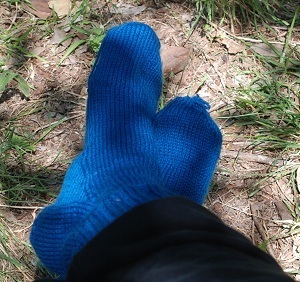
But until I get the loopy/bulky toes fixed, I can't wear this pair for real walking, etc. Supposedly, you can start pulling the loops snug on the starting side of the grafting, and work your way across, but I can't find one on that end that will pull. Here are the toes:


The right toe's better than the left. You can at least see on the right one that the stitches should flow right across the toe end. But I started on the left one and was interrupted repeatedly, each time losing my concentration for long enough to make a mistake. Undoing the mistakes and trying to redo them was not only frustrating, but made the yarn fray and fuzz (it didn't help that two of the interruption-errors involved splitting the yarn with the strand I was using for grafting.
Another error, not caused by interruptions, was that I made the left toe slightly too short. Just enough that I "feel" the end of the sock all the time. To make up for that, the right one's just a little long. Learning experiences, I tell myself. On the whole, the socks fit better than before, though. The slightly snugger cuff does leave an impression on my leg (so, no tighter!) but nothing like the dug-in groove that store-bought socks with their elastic leave.
These socks do have a left and right--and when I can do grafting better, I'll like that a lot. My big toes don't like even gentle knit-sock-tension pushing them toward the center of my foot. This way I make the sock straight up the "inside" or medial side, with a curve on the outer or lateral side.
Next up: Green One, the first green pair. And I'll put a pair of...probably red....on the needles tonight or tomorrow.
April 26, 2012
Blue One Progress

Gussets clearly visible between heel flap, bottom, and top of foot.
Since I'm making the pattern for socks for myself from scratch, I try the socks on multiple times during their growth...and for this pair, compare the feel of the first pair to this pair. I wanted the socks to fit somewhat closer but not tightly. The difficulty compared to "textbook" legs, feet, and ankles is that I have some swelling in my lower legs and ankles, but much less in my feet. So I need a wider cuff than foot....how much to reduce the width in that gusset is still up for review, but this pair definitely fits better than the first pair.

Still a little looser at the heel, but fits better around instep. Next pair will reduce 2-4 stitches
below cuff ribbing before making heel flap.
Although I'm wearing these socks over thin socks for the pictures, they won't be worn over other socks ordinarily, so I want a fairly snug feel over the under-socks. Here are a couple of closer-up pictures that show the fit from heel to past the gusset. Needles distort the first few rows, of course. (But it's a lot easier to try them on with 4 needles than 3!!
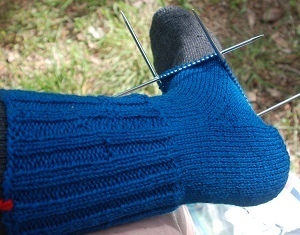

The sock on the left has a smoother join at the gusset but some mistakes in the cuff ribbing. The sock on the right has smoother cuff ribbing but a rougher join at the gusset. Learning goes back and forth between the two socks in the pair. You may be able to see a little of the fullness at the back of the heel on the sock on the right. In that space between the cuff ribbing and the gusset angle is where I'm thinking of taking out a few stitches. Then I won't need to decrease as many in the gusset itself.
And Green One socks, the pair after Blue One, both now have ribbing long enough that it won't easily invert itself through the space between needles.
Yesterday, between supper and choir practice, some of the kids who are in the various youth choirs were hanging out where I was knitting. I was working on the cuff ribbing of one of the Green One socks, but had Blue One with me as well, and was wearing Red One, the very first (and full of errors) pair. Some were more interested than others, including one tiny one who must have been no more than four or five. . Not only was she interested, but she was asking really good questions. Also attracted a woman who had been convinced that socks were far too hard for her, since her one sweater turned out badly. I showed off Red One's mistakes--that clearly left it still wearable as socks--and admitted I'd been scared to attempt socks for decades because I believed they were incredibly difficult. I told her about YarnHarlot's Knitting Rules, the book that--with a little internet video help--got me through my first pair (and I still need it for heel turning--her description is clear enough and brief enough for the most novice or novices...like me.) She kept saying "You make it sound easy" and I kept saying "I was amazed how easy it was, mistakes and all." Maybe she'll try it herself.
I would really like to finish Blue One in the next few days. That would uncrowd my knitting bag (since I'm carrying around the two Blue One socks and the two Green One socks, tiny as they are right now) and besides I've have two pairs of handknit socks to wear, one of which would fit much better than the other. I need at least three pairs of socks to take to A-Kon....and all my store-bought thick socks have holes, besides being so much less than comfortable. (I hate elastic in the ribbed cuffs. I especially hate really tight tops of socks. They make dents in my legs.) I'd really like to have four pair...and in the long run, many more than that. Red One takes two days to dry--I'm wearing that pair twice a week (Wednesdays, when I have voice lesson and choir which means lots of standing, and Sundays, when I'm singing at services and that means lots of standing, too.
I've now acquired some Superwash yarn, but since I don't mind handwashing wool socks, I'll go through the original colors first, while working on the pattern. Naturally both husband and son now want socks (and theirs will be Superwash wool--not trusting them to remember which is which) and I've got two more pair promised elsewhere, one for a friend who needs them to wear over compression stockings (which give no warmth, she says.)
April 25, 2012
Lifestuff and Major Distractions
But I do have one distraction to report on, that's leading up to something that may be entertaining for some of you. BBC Radio asked me to be on their program The Forum, for a discussion of Future Wars. This is the first time I've discussed future warfare with anyone other than SF writers/fans or military folk who were SF fans. It won't be same-old same-old. I'm delighted to be part of this particular discussion.
Since they're in London and I'm not (and no, it was not possible to make a quick trip to the UK to be there--thanks to other LifeStuff) this involved quite a flurry of email traffic between my UK publisher's publicity person and me, some delayed emails (I don't know if mine back were delayed, but some of hers to me took a couple of days to waft here) and then another flurry of email traffic between the BBC and me, and then a phone call yesterday. I'm not accustomed to overseas phone calls--they're still a big deal--but the connection was very, very clear. BBC had to find a studio they could use, here in Texas; I had to figure out where it was (well, actually, when they sent the address, I knew I wouldn't have a problem finding it. A friend has agreed to drop me off across the street from it, so I don't have to worry about where to park.)
Now to get back to normal stuff (the book lost ground last week and early this, due to the excitement factor. Need to get a normal day's work done today--and that means staying off the internet until it is. Except for this.)
April 15, 2012
Blue Socks: more progress
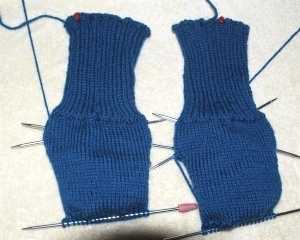
The front of the sock (where the top of the foot will be) is on the bottom in the this picture, with its needles sticking out of it. The sides of the heel flap appear to slant in to the turned heel. It's hard to see in this photo that the heels really have turned. so here are a couple more pictures:
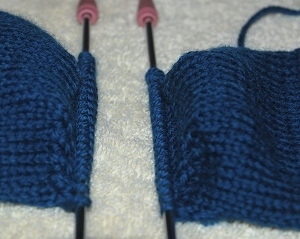
Here the heels are "nose to nose" or "heel to heel," forming an arch and with the central stitches pointing "down" (what will be forward, on the bottom of the foot, when the sock is on. Unlike the heels of the first (red) pair, these heels look alike and are smoother.
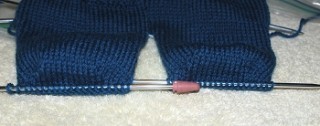
And here they are side by side, again showing that they're the same size and shape. Hurray, I said last night. Now all I have to do (!!) is pick up the stitches along the sides of the heel flap, reconnect at the top to the front/top of the sock, do the gusset, then the foot, and then...somewhere in the front and future...the toes. And I'd better do it pretty quickly, as I need to get these, and another pair, done by the end of May. Along with quite a good-size chunk of the next book and various other things that need doing.
Elizabeth Moon's Blog
- Elizabeth Moon's profile
- 2621 followers



